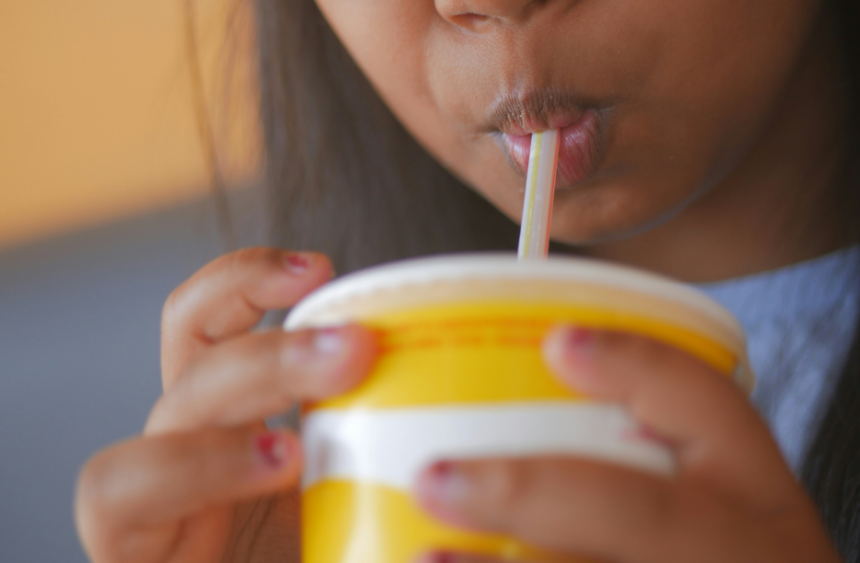Sprite and Fanta both contain less sugar than Coke, but still have more than the juices we compared.
“Coke is still the worst,” says Mphaphuli. “It’s loaded with too much sugar and because it contains caffeine, it can combine with sugar to give that high, followed by a low, which can make children [especially] irritable.”
Research has linked high sugar consumption to poor sleep quality in children. A study of more than 1,000 kids in the Journal of Pediatrics found that those who consumed the most sugar slept for the least amount of time and had the most disrupted sleep.
“If you’re giving your child Coke before they go to bed, they’re going to be up all night,” Mphaphuli adds.
Energy drinks
Monster is the energy drink with the most sugar, followed by Red Bull and Play. But all three energy drinks have more sugar than all the juices we compared, except for Coke.
“Energy drinks are just a disaster,” says Mphaphuli. “They’re a double whammy — they’re loaded with sugar and caffeine, which can give you that high, followed by a low, that can make you lethargic.”
While the proposed regulations would require energy drinks to carry a warning label, the black-and-white triangle, only half of all energy drinks sold on the market would need one.
“Energy drinks are more dangerous than sodas. They can really affect your heart rate and blood pressure,” Mphaphuli explains. “They’re not meant for children. They’re meant for adults who are going to be physically active.”
Under the proposed regulations, the warning label would be a big change for energy drinks, which currently only carry a label that says “not recommended for children, pregnant or breastfeeding women and individuals sensitive to caffeine”.
But not all energy drinks are the same. Some contain more sugar and caffeine than others. So, 85% of all energy drinks sold in the country would need a warning label if the regulations were to be passed.
Ultimately, the research shows that fruit juices, sodas and energy drinks all have high sugar content, which contributes to childhood obesity and other health issues. The proposed food labelling regulations aim to raise awareness about the sugar content in these beverages and help consumers make healthier choices for themselves and their families. It remains to be seen whether the regulations will be passed in their current form, but the conversation around sugar and its impact on health is an important one to have.
Too much caffeine can have negative effects on your body, including anxiety, restlessness, and changes in your heart rate. It’s important to be mindful of how much caffeine you consume, as it can have a significant impact on your overall health.
The World Health Organization recommends that adults should not consume more than six to 12 teaspoons of sugar per day. However, many popular beverages, such as soda, contain excessive amounts of sugar. For example, a 440ml can of Coke contains about 11.5 teaspoons of sugar, exceeding the WHO’s recommended daily limit. South Africans consume an average of 254 Coca-Cola products per person per year, which is almost triple the global average.
Before South Africa implemented a tax on sugary beverages in 2018, many sodas contained high amounts of sugar. Some manufacturers adjusted their recipes to lower the sugar content and added non-nutritive sweeteners to maintain sweetness. While these artificial sweeteners may help with short-term weight loss, they should not be relied upon for long-term health benefits. The International Agency for Research on Cancer has even listed aspartame, a sweetener found in diet drinks, as a possible carcinogen.
Energy drinks are another popular beverage that can be high in sugar and caffeine. These drinks often contain artificial sweeteners and can have up to 13 teaspoons of sugar per 500ml can, exceeding the WHO’s daily sugar recommendation for adults. Experts advise against consuming more than 100-175mg of caffeine per day, yet many energy drinks contain close to this maximum amount per can.
Flavored waters, despite being marketed as healthier options, can also contain significant amounts of sugar and artificial sweeteners. It’s important to read labels carefully and opt for plain water as the preferred drink choice. The new regulations will require sugary drinks containing artificial sweeteners to carry warning labels about the potential health risks associated with excessive consumption.
In conclusion, it’s essential to be aware of the sugar and caffeine content in the beverages you consume. Too much caffeine can lead to anxiety, restlessness, and changes in heart rate, while excessive sugar intake can have negative effects on your overall health. Choosing water as your primary beverage and limiting your consumption of sugary and caffeinated drinks can help you maintain a healthier lifestyle. the perspective of a travel blogger who recently visited a remote island in the Pacific Ocean.
I recently had the incredible opportunity to visit a remote island in the Pacific Ocean, and it was truly a once-in-a-lifetime experience. The island, which I will not name in order to preserve its pristine nature, is a hidden gem that is not frequently visited by tourists. It is only accessible by boat, and the journey to get there was an adventure in itself.
As we approached the island, I was struck by its beauty. The crystal-clear waters sparkled in the sunlight, and the lush green forests that covered the island’s mountains were a sight to behold. The island was uninhabited, with only a few small huts scattered along the shoreline where local fishermen would stay during their expeditions.
I spent my days exploring the island, hiking through the dense forests and discovering hidden waterfalls and secluded beaches. The wildlife on the island was abundant, with colorful birds flying overhead and tropical fish swimming in the shallow waters. I even saw a pod of dolphins playing in the distance, a sight that took my breath away.
One of the highlights of my trip was meeting the local fishermen who lived on the island. They were incredibly welcoming and hospitable, inviting me to join them on their fishing expeditions and teaching me about their traditional ways of life. I learned how to catch fish using traditional methods, and even helped them prepare a delicious meal using the day’s catch.
At night, I would sit on the beach and watch the stars twinkle in the night sky, far away from the light pollution of the city. The peacefulness and tranquility of the island were a welcome escape from the hustle and bustle of everyday life, and I found myself feeling more relaxed and at peace than I had in years.
As I reluctantly said goodbye to the island and boarded the boat back to civilization, I knew that this trip would stay with me forever. The remote island in the Pacific Ocean had captured my heart, and I couldn’t wait to share my experiences with the world. I would highly recommend visiting this hidden gem to anyone looking for a truly unique and unforgettable travel adventure.







